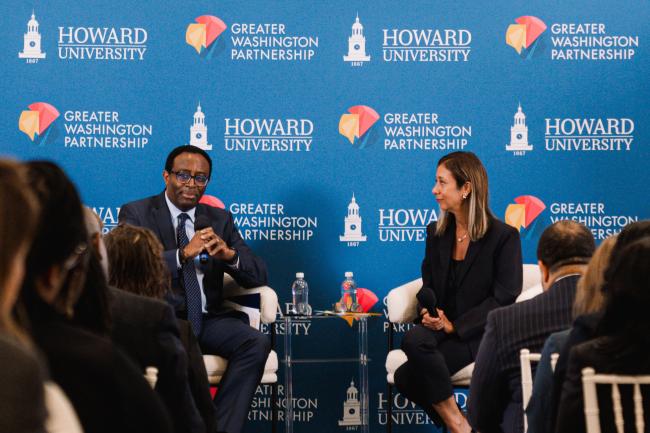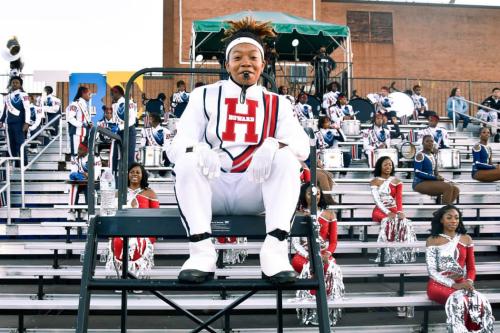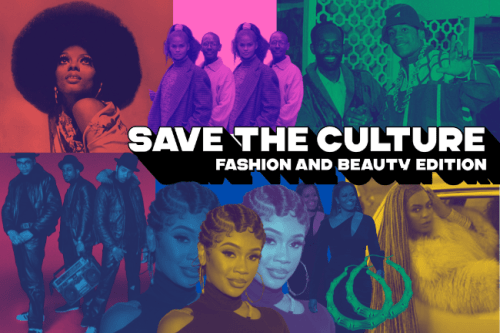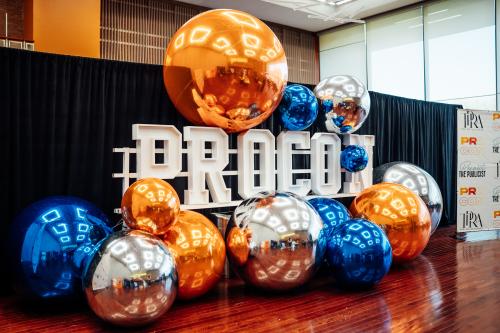Howard University President Ben Vinson III, Ph.D., joined regional economic partners to discuss “HBCUs as Catalysts for Regional Inclusive Economic Growth.” The event centered on the release of a study which detailed Howard’s $1.575 billion economic impact in the Washington, DC region and the similar impact other HBCUs have on communities around the country.
“In addition to thought and cultural leadership, Howard University has long been an engine of economic equity in the District of Columbia and the surrounding Washington metropolitan area,” said President Vinson. “This is just the latest example of the concrete, measurable, and uplifting impact that Howard has on our surrounding community and HBCUs have on our society. As we grow our community and attract more research investment, Howard will continue to be positioned as a matchless force of intellectual and economic energy that powers one of the world’s most important cities.”
The findings were based in part on expenditures by the University and its nearly 18,500 employees and students. For example, the University invested $395 million in its faculty and staff through its fiscal year 2024 payroll and engaged more than 2,300 vendors in the acquisition of goods and services worth more than half a billion dollars. In 2019, students alone spent over $25 million on retail consumer services, entertainment, dining, and other convenience goods.
President Vinson emphasized HBCUs leading the region in inclusive economy prosperity. Nine HBCUs are located within or near the 150-mile stretch from Baltimore to Richmond. President Vinson highlighted the importance of working closely with Howard’s fellow DC HBCU, the University of the District of Columbia. UDC President Maurice D. Edington, Ph.D., also attended the event.
“Certainly, we are anchor institutions, but at the same time, we are institutions that set sail to a city and a region, and we need to be thinking about the impact not just in grounding a region, but in animating a region.”
President Vinson noted that Howard not only drives economic opportunity, but it also administers programs which help educate business owners, provide them with technical assistance, and connect them to resources. He emphasized that the university triggers secondary and tertiary spending by others. In line with its mission, the university focuses on uplifting communities.
President Vinson was joined by Kathy Hollinger, chief executive officer and president of the Greater Washington Partnership, at the event. Founded in 2016, the Greater Washington Partnership looks to ensure the success of underserved communities from Baltimore to Richmond.
“This is smart economics,” she said. “Taking on an inclusive approach to growth propels not only our region’s businesses, but also our communities.”
Nina Albert, DC’s Deputy Mayor for Planning and Economic Development, was featured in a videotaped conversation with Rashad Young, Howard’s senior vice president and chief strategy officer, where they expounded upon the University’s impact in the District of Columbia. “Howard has done a tremendous job of being outward looking and expanding so that the University footprint isn’t just limited to students and faculty, but really helps support local economic development,” Albert said, making note of the institution’s “tremendous legacy” with standout educational and medical components.
“DC is a historically Black city, so when we think about our future economic growth, we think a lot about how that inclusivity and diversity welcomes, attracts, and retains people who are investing,” Albert said. “I think there’s great opportunity for a partnership between Howard and the District of Columbia.”
By the Numbers: Howard’s Impact Around the Capital
Per the Howard University’s Office of External Affairs, University enrollment is expected to surpass 15,000 students and Howard’s faculty and staff will total over 7,500 employees by 2030. Future projects will support 28,280 full-time, year-round jobs in both the DC metropolitan area and across the country.
President Vinson also discussed the University’s real estate strategy, including goals to create 250 affordable housing units by developing nine off-campus commercial mixed-use projects through an $1.3 billion investment. Of those nine projects, four have been completed or are near completion. As of September 2024, the real estate plan has created over 13,254 jobs and $710 million in earnings. Howard’s development is managed in concert with those who live and work in the neighborhoods surrounding the university and is purposeful in its engagement with minority businesses.
“When we build these projects, they add to the overall quality of life to the neighborhoods that we are a part of,” said President Vinson. “We are very intentional about that.”
Others spoke to Howard’s historic economic impact, such as Tony Pierce, partner of the Akin Gump Strauss Hauer & Feld LLP law firm. As a native Washingtonian and lifelong resident, Pierce spoke to the critical role Howard University maintains in building an accessible future for the greater Washington area.
“Our region is rooted in a culture of entrepreneurship and innovation, and HBCUs are essential to nurturing that spirit,” said Pierce, who is also a board member of the Greater Washington Partnership and a mentee of late Howard alumnus Vernon Jordan (J.D. ’60).
A Focus on the Future
In his conversation with Hollinger, President Vinson identified Howard University as an “economic driver.” As one of seven major universities in the DC area, he argued that Howard has a distinctive role in creating “inclusive prosperity” in a historically Black city.
“We create jobs, we attract talent, we generate substantial economic activity, we are also a stable presence in our community,” President Vinson said. “We’ve been here since 1867. That’s 157 years we’ve been part of this community, a part of the District of Columbia. We’ve seen this city grow...we invest in our community, we provide programs, services, and support.”
Hollinger shared updates of the Greater Washington Partnership’s Collective Action for Shared Prosperity strategy to spend $4.7 billion over five years to uplift the businesses, opportunities, and economic growth of the underserved. So far, the Greater Washington Partnership has spent $2.1 billion, crossing the 70% spending threshold in just two years.
“Inclusive growth is a core pillar of our mission at the organization, and we deliver on this through tangible, measurable initiatives…that really focus on investing in people, infrastructure growth and communities,” Hollinger said. “We really think about how we can build a more resilient, competitive economy to expand education, job training, and transportation. They’re all designed to ensure that economic opportunities are equitably distributed to ensure these concepts are grounded in action.”





